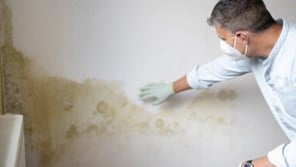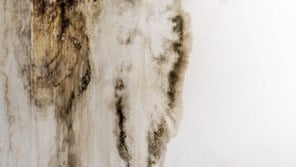Does home insurance cover mould?
8 minute read

While treatable in most circumstances, mould is not to be overlooked. In this article, we’ll explore how mould appears, what you can do to prevent this, and whether mould damage will be covered by your home insurance.

Get Home Insurance
Age Co helps homeowners over 50 find the right protection. We are 100% owned by Age UK and our profits go back to the charity.
What is mould?
Mould is a type of microscopic fungi that thrives in damp and poorly ventilated areas. It can grow outdoors, indoors and on a range of surfaces from timber to textiles.
Often appearing as black/grey dots, smears or discolouration, mould can quickly grow into a cloud-like cluster. Depending on the type of mould, and how developed it is, you may also see it appear in a variety of colours, including orange, green, red, brown, white, pink or even purple.
There are many varieties of mould, some of which are more harmful than others. If in doubt, it’s always best to seek advice on any markings in your home. Types of mould you may find at home include:
1. Alternaria – with a velvet/furry dark appearance, Alternaria is classed as an allergenic mould. You can find it around showers, baths and sinks. It can be a sign of water damage.

2. Chaetomium – though it starts as a white, cotton-like substance, Chaetomium will darken to a grey, brown or black colour over time. You’ll most likely see it in areas prone to water damage such as roofs, pipes and cellars.

3. Stachybotrys – commonly called Black Mould, this variety is classed as toxigenic and can cause severe health problems. It’s dark, slimy and grows in areas that are damp and wet. It’s essential that this type of mould is treated quickly and that expert advice on how to do this safely is found as soon as possible.

4. Trichoderma – Trichoderma is an allergenic mould with a white/green, woolly appearance. It thrives in condensation-rich areas as well as wet fabrics and wallpapers.

5. Ulocladium – black in colour, Ulocladium is frequently found in rooms prone to condensation and steam such as bathrooms and kitchens.

What causes mould?
If you have an area that’s been exposed to water or moisture and it receives little light or air, it may be prone to mould. From cold corners to uninsulated walls, there are many spots in your home that mould can target. Common causes of mould include:
Condensation
Condensation is the most common cause of mould growth in our homes. It is formed when moist air comes into contact with a colder surface and creates droplets. You’ll most likely notice condensation on areas such as windows, walls, mirrors, kitchen cabinets or bathroom tiles and it’s even more prevalent in winter months.
Penetrating damp
Penetrating damp occurs when water or moisture makes its way into your home through an external wall. This could be linked to a leaking pipe, damaged brickwork, or blocked guttering. Thankfully, it’s an issue that can be solved fairly easily with the help of an expert and the right products.
Rising damp
If your house has a poor damp course, or no damp course at all, you can experience rising damp. You can often spot rising damp by the ‘tide mark’ it leaves on your walls. If you suspect you may have it, it’s best to call on the help of a professional.
Water damage
Whether it’s a leaking roof or a plumbing problem, there are lots of different issues that can cause water damage to your home. This damage will often lead to a damp area where mould will go on to grow.
How do I get rid of mould?
To successfully tackle a mould issue, it’s best to start by identifying the source of moisture or water it is using to grow. Without tackling the root of the issue, you’ll likely see it return even after a thorough clean.
How you clean areas of mould will depend on your house, preferences and circumstances. There are lots of different mould cleaning products and methods on the market, from natural remedies and household sprays to more targeted treatments. These include:
Sprays with bleach
Cleaners containing bleach can be used to remove the stains that occur with mould. However, they won’t be suitable for all surfaces and should be used with caution and in line with the manufacturer’s instructions. Not all such cleaners have antifungal ingredients either.
Anti-fungal sprays/cleaners
Available from most DIY stores or online, these cleaners use active ingredients to tackle issues such as mould, mildew and algae. Specialist sprays/cleaners are also available for dedicated materials such as carpets or masonry stone.
* Please be aware that you should never mix cleaning products as the ingredients in different solutions can cause potentially dangerous chemical reactions therefore caution should be applied.
Natural options
Substances such as vinegar or lavender, clove and eucalyptus oils have all been cited as potential ways to fight mould over the years. However, not all of them are up to the task and it’s important to think of staining or smells that could be left behind, especially on surfaces like fabric or wallpaper.
Ask the experts
If you’re in doubt about the type of mould you have in your house, it’s worth getting professional help. In houses with problems such as rising damp, you’ll definitely need to seek the support of a local professional builder to explore your solutions in more detail.
How can I help to prevent mould in my home?
Whilst mould issues are inevitable in most homes, there are steps you can take to try and reduce the likelihood of encountering them.
Minimise moisture
There are all sorts of ways you can reduce moisture levels in your home. This can include keeping your pan lids on whilst you’re cooking or drying your clothes outside. Having a lot of potted plants can raise humidity levels too, so balance this by ventilating your rooms when you can.
Open windows
Opening windows to ventilate your home can help prevent moisture build-up and provide protection from mould. As well as this, you can help keep your windows clear of condensation by wiping them down each morning; find out more on how best to clean your windows to prevent condensation from forming with Shark’s handy guide.
Regulate your heating
Where possible, maintain a constant room temperature to help reduce the chances of mould. Of course, this should be balanced in areas that are often unused so as not to waste money or energy, and you could always draft-proof or replace inefficient windows where possible to help this further. Framing your windows with lined curtains, kept open during the day and drawn at dusk, will also help with room temperatures by making the most of the heat from the sun.
Consider specialist equipment
Depending on your space, and mould issue, equipment such as dehumidifiers and extractor fans could be well worth exploring. Extractor fans can often be useful in kitchens and bathrooms as they’re great at getting rid of steam and stopping it from spreading around your home.
Dehumidifiers also work to take moisture out of the air and they’re available in a number of different sizes, types and price bands. According to a guide produced by Oxford City Council, mould is likely to occur if the humidity indoors is 70% or above. Using a humidity meter can be a great way to monitor your levels. This way you can keep them low enough to avoid mould, whilst being high enough for you to live comfortably and healthily.
Switch up your space
Mould likes to grow in darker, damp areas with restricted ventilation. Cupboards, wardrobes and pieces of furniture provide the perfect spots for these conditions to develop. So, where possible, it’s great to intermittently move small pieces of furniture around where manageable, to increase circulation and keep them away from outside walls.
Use mould-resistant paint
Once you’ve cleaned away mould, mould-resistant paints can help treat the area and stop it from returning. You can’t simply paint over the mould though, as it will continue to grow under the paint which is why removal first is important.
Will my home insurance cover mould?
The answer to this question will depend on your provider and policy. Mould might be covered by your policy where it occurs in relation to an insured event. For example, mould that develops as a result of incidents such as an escape of water, storm damage or a flood.
Mould is unlikely to be covered where it’s developed through a lack of property maintenance or certain home keeping habits. If you don’t follow expert advice on how to prevent and treat mould, it will inevitably cause a gradual build-up over time. This type of mould issue is a maintenance matter rather than insurance. As such, most policies will not provide cover.
Does home insurance cover mould from a roof leak?
As the homeowner, you’ll be responsible for providing general roof maintenance to keep it in good, working order. If you fail to do this and the roof leaks, most insurers won’t cover any damage that occurs. However, if the roof leak has happened as a result of damage linked to an insurance event (such as a storm), your policy might cover this instance.
Mould can appear in our homes for many reasons. However, with the right advice and practices in place, we can certainly do our best to spot, stop and slow its presence. If you’re wondering if your home insurance covers mould from a roof leak or faulty pipework, it’s always best to speak to your provider.
Summary
Mould can appear in our homes for many reasons. However, with the right advice and practices in place, we can certainly do our best to spot, stop and slow its presence. If you suspect mould is developing in your home, keep these key points in mind:
- Damp conditions, such as condensation, can cause mould to develop, which is why you may find mould around window frames and in your bathroom.
- Mould can sometimes be removed through spraying bleach or the use of specialist anti-fungal cleaners. Keep in mind that you should never mix cleaning products as the ingredients in different solutions can cause potentially dangerous chemical reactions.
- To stop mould from developing, you can either use mould resistant paint or minimise damp conditions in your home.
- If you’re wondering if your home insurance covers mould from a roof leak or faulty pipework, it’s always best to speak to your provider.

Sign up to the Age Co Newsletter
Each month, our email newsletter delivers inspiring stories, practical guides to later life, plus the latest news about Age Co and the charitable work we support.
